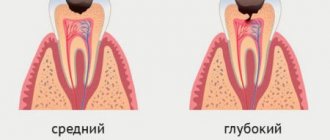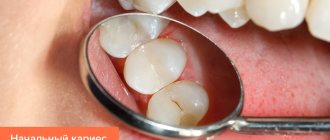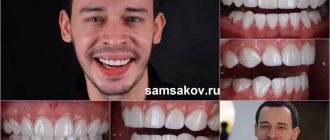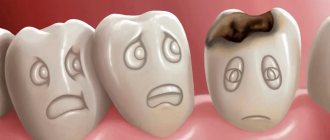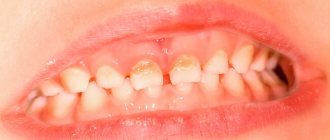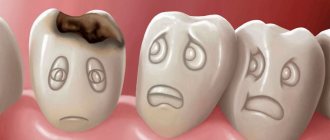Treatment of dental caries in Moscow is carried out using modern technologies and using high-quality filling materials. And, it would seem, the filled tooth is already completely insured against the emergence of new problems. But do not forget that the cause of the formation of carious lesions is a bacterial infection. Demineralization and destruction of dental tissues are caused by pathogenic acid-forming bacteria. And if the microflora of the oral cavity is not controlled by the patient, restoration of a dental crown performed in the clinic will not exclude the possibility of the formation of recurrent or secondary caries.
This is a very pressing dental problem for both the patient and the doctor. Firstly, repeated treatment requires significant financial costs and takes up quite a lot of the dentist’s working time. Secondly, relapse is often practically asymptomatic, so hard dental tissues are thoroughly destroyed, increasing the risk of pulpitis formation.
Let's figure out why caries occurs under a filling, and whether its occurrence can be prevented.
Secondary and recurrent caries: is there a difference?
Dentists of the Soviet school for a long time considered these concepts identical, because there really is a lot in common between them. Currently, dentists interpret them differently.
- In secondary caries, the pathological process continues to develop after filling the tooth due to the insufficiently tight fit of the filling to the walls of the carious cavity.
- Saliva, which contains enzymes produced by the body, as well as pathogenic bacteria and acids that are products of their vital activity, penetrates into the resulting marginal microgap.
- They have a destructive effect on all types of filling compounds: they increase the moisture absorption of dental cements, activate the corrosion of amalgam fillings and disrupt the mechanism of adhesion of composite materials to the dental surface.
But recurrent caries affects a tooth under a filling in cases where, during treatment, the affected necrotic dentin was not completely removed from the walls of the treated carious cavity or the cavity was poorly treated with an antiseptic. Recurrent caries is, as a rule, a consequence of the dentist’s lack of proper experience or mistakes made by him.
In addition, both processes can develop in parallel, which significantly complicates and increases the cost of treatment.
Uniform darkening
If after a few days or weeks you suddenly see that the installed filling has evenly changed its color and has become, for example, pink or yellow, this most likely indicates a violation of your dentist’s instructions. Perhaps you did not listen to the advice of a specialist and ate some coloring vegetable or drank strong coffee without milk.
To eliminate this defect, be sure to seek help from your doctor. He will be able to polish the composite material and perform a high-quality cleaning, as a result of which the filling will again become its original color. After this, you will not be able to eat food containing dyes for some time. Otherwise, all the efforts of the master will be in vain.
Old fillings are also susceptible to staining. This may be due to the fact that the patient exposes them to too sudden temperature changes, that is, he may eat ice cream and drink hot tea at the same time. All this leads to changes in the volume of the filling: it can imperceptibly narrow and expand. As a result, microbes and food particles penetrate into the small cracks and cracks that form. This filling can either be replaced or polished.
Is it possible to determine for yourself why a tooth hurts after a filling?
Secondary caries may not make itself felt for a long time.
- At first, the presence of a problem is only indicated by bad breath, which appears shortly after brushing your teeth.
- Then discomfort or a slight painful reaction to temperature and mechanical stress may appear.
- An attentive patient can detect darkening of the tooth enamel in the area of the filling, the formation of an edge gap, and even mobility of the filling itself.
All these signs indicate ongoing tooth decay and indicate the need to urgently seek professional help.
The recurrent process is more active and appears within a couple of weeks after tooth treatment. The patient complains of aching toothache, which is a consequence of the involvement of the dentinal tubules in the process and the advancement of infection to the pulp chamber. Visually, no changes are observed in the area of contact between the filling material and enamel. In this case, you should immediately consult your doctor to prevent inflammation of the pulp and treat the tooth.
To exclude the possibility of the formation of a new focus of caries and to ensure that the carious cavity has been properly cleaned and treated, dentists use the so-called caries marker. This is a liquid applied using a foam ball and distinguishes between healthy and damaged dentin. It turns the destroyed tissue bright red, showing the dentist exactly which areas need to be removed.
Associated symptoms
In addition to blackening of the enamel, other symptoms may develop:
- The appearance of erosions, gouges, black spots or spots on the enamel.
- Unpleasant odor from the mouth.
- Mobility of the filling.
- Pain when pressing, tapping or chewing.
- Inflammatory process in the gums around the filling, bleeding of the mucous membrane, swelling. The appearance of bumps or gumboil in an advanced stage.
Changes in tooth color should not be ignored. This is a clear sign of a pathological process.
What determines the result of filling?
A tooth after filling can be destroyed by secondary caries for several reasons.
- When consuming cold and hot food and drinks at the same time (for example, cold ice cream and hot coffee or hot kebab and cold beer). In such cases, under the influence of a significant temperature difference, microcracks form in the tooth enamel and in the places of contact of dental tissues with the filling material.
- The seal may shift slightly when chewing on too hard, tough foods. This will be enough for a microcrack to appear.
- Malocclusion and pathology such as bruxism are accompanied by excessive friction of teeth against each other and cause accelerated abrasion of the filling composition and dental tissues.
- An insufficient level of hygiene leads to the settling of food particles and the formation of a significant amount of soft plaque in the fissures (tubercles on the chewing surface of the teeth) and in the interdental spaces. This accelerates the development of a bacterial infection.
What causes a filling to change color?
Some patients experience changes in the shade of the filling. Blackening of the filling occurs due to various factors:
- Failure to comply with oral hygiene rules.
- Formation of abundant bacterial plaque or tartar.
- Excessive consumption of pigmented foods.
- Deposition of tobacco tar on the enamel due to smoking.
In rare cases, a filled tooth may appear darker after a professional cleaning or whitening procedure. Light-curing filling compounds are selected in a shade to match the color of natural teeth. During the whitening process, the color of the fillings does not change and they appear darker against the background of the rest of the row.
How is caries under a filling diagnosed?
When treating diseases of the teeth and gums, dentists often need to take x-rays. Unfortunately, when studying an x-ray, not every doctor pays attention to the condition of previously filled teeth and existing fillings.
Meanwhile, it is the X-ray data that allows:
- identify pathological changes in the area of contact between the walls of the treated carious cavity and the filling material;
- assess the degree of their development.
Recently, in Moscow clinics, the condition of fillings is assessed using a modern and even safer technique of visioradiography. Digital X-ray equipment increases the information content of diagnosing the condition of dentin under a filling and allows you to view all the details on a computer monitor. The examination is accompanied by significantly less radiation exposure to the patient compared to traditional radiography.
Darkening around the perimeter
If the patient notices a clear change in the color of the filling along the edges, where it adheres to the tooth, the problem is most likely not due to coloring products. This may indicate that the filling material does not fit tightly enough into the cavity and is not completely sealed. As a result, bacteria and dirt penetrate into the open gap, which gradually leads to darkening and destruction of the material.
The only possible way out in this situation is to replace the filling with a new one. This must be done even if at first glance the filling looks great and does not cause any discomfort. It can cause the development of deep caries and other dental diseases, such as pulpitis.
What conclusion can be drawn? In any case, contacting your dentist if the filling darkens is mandatory. You should not try to correct the situation on your own at home; traditional methods will be powerless here.
previous post
Tool fragment in the channel
next entry
The tooth under the filling hurts. What does the treatment method depend on?
When treating secondary dental caries, the dentist must choose the right tactics: either correct the filling, or remove it and refill the cleaned and treated cavity. In some cases, after removing the affected tissue, the cavity turns out to be so large that to restore the dental crown it is necessary to use special inlays or cover the treated tooth with a crown made from an impression.
- There is no need to remove the entire filling if the chewing surface in the area of only one of the walls of the carious cavity has suffered from secondary caries. Necrotic tissue is removed, a cavity is formed and filled with the same filling material. Then the filling is ground and polished.
- If the infection has spread to several sides or around the entire filling, it is removed, the cavity is formed and treated, and the filling is refilled.
Prevention
You can prevent blackening of a tooth under a filling with the help of effective prophylaxis. To avoid the need for re-treatment, you should follow several rules:
Firstly, follow all the hygiene instructions of doctors - brush your teeth in a timely and regular manner, using the right toothpaste, floss, and rinses. Secondly, undergo preventive examinations in a timely manner in order to identify and treat any diseases in the early stages, before complications arise.
Try to avoid temperature changes - do not eat hot and cold food at the same time, do not drink hot drinks in the cold. Avoid traumatic effects - do not gnaw hard food (nuts, seeds) with filled teeth. Treat any infectious diseases in a timely manner, including those that are not directly related to the oral cavity.
Get rid of bad habits that disrupt the body’s activities and weaken its protective functions. Do not skimp on tooth restoration and, if the filling has darkened, replace it in a timely manner.
Features in the use of materials
It happens that the tooth turns black under the filling due to the fact that low-quality material was used. This can give the crown a brown and black tint. This kind of defect is not easy to fix. Especially when the patient visited another clinic and the therapy was carried out a long time ago. The service life of good composite overlays is at least seven years. But it happens that during treatment the root canal was not completely filled. This causes the problem to appear quickly.
Outdated filling cements can distort light refraction and also become dark from light. In such a situation, pathogenic bacteria actively multiply in the microscopic cavities of the units. This is facilitated by small particles of food that accumulate in the voids. Decay products collect in the dentinal tubules. All this causes a change in the color of the crowns. Even with light enamel, the color of the crowns can change, since the yellowness of the dentin is visible through the transparent layer of enamel.
Today, laser dental treatment is widely used, after which there are no defects. What problems does this technology solve?
- Sterilization of cavities from caries.
- Disinfection of root canals.
- Excision of the pathological “hood”.
- Sterilization of pockets for periodontitis.
- Removing infections and opening abscesses.
- Gum plastic surgery.
What to do if the tooth has darkened
You just need to come to the clinic for a consultation. We will remove the prosthesis and find out the cause of the strange sensations. If the crown has already been removed and a darkened tooth is visible, we will consider options for saving it. First you need to determine the condition of the root and undergo a course of treatment. In the case when it is already destroyed, removal of the remains will be required, followed by implantation.
Is there a healthy root? Then you can install new crowns on your teeth quickly using Cerec technology
.
New technology eliminates errors. This is an opportunity to make ideal dentures and quickly cover a tooth with a crown. Steps:
- The scanner determines the characteristics of the damage; adjacent and opposite units and closed rows are scanned.
- The program combines information and creates a 3D model of inlays and crowns, taking into account anatomical features. The computer calculates the dimensions of the prostheses and the nuances of their shape.
- Even before the process begins, the patient can see the result. We select the shade - each change is agreed with the patient.
- A special machine makes an inlay and a crown from a blank.
- During fitting, it is rare, but the need for correction arises. In most cases, these are nuances of the shade of the crown. But a new copy according to the template is made within 15 minutes
. - The crown or inlay fits tightly to the remaining parts of the tooth, preventing pathogenic microflora from entering the tissue.
The process takes only 1.5 hours and allows you to save a darkening tooth. This technology is the best that has been created in dental practice. Allows you to quickly and accurately produce single versions of crowns for teeth or bridges from metal-free materials - ceramics and zirconium dioxide. We will discuss the nuances of your particular case during your visit; the cost of installing a crown on a tooth starts from 27,900 rubles. There are promotions and special offers. Keep your teeth healthy and your body will thank you.

